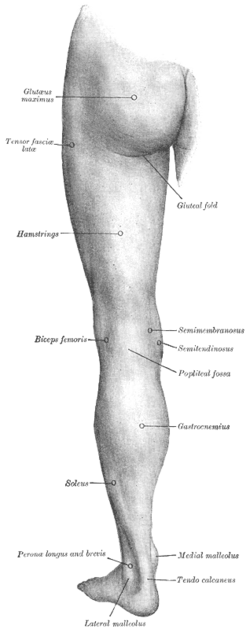Hamstring
| Hams | |
|---|---|

Posterior view of left lower extremity.
|
|
| Details | |
| Origin | tuberosity of the ischium, linea aspera |
| Insertion | tibia, fibula |
| Artery | inferior gluteal artery, profunda femoris artery |
| Nerve | sciatic nerve (tibial nerve and common fibular nerve) |
| Actions | flexion of knee, extension of hip |
| Antagonist | Rectus femoris muscle |
| Dorlands /Elsevier |
h_02/12407578 |
|
Anatomical terms of muscle
[]
|
|
In human anatomy, a hamstring is one of the three posterior thigh muscles (from medial to lateral: semimembranosus, semitendinosus and biceps femoris).
In quadrupeds, the hamstring is the single large tendon found behind the knee or comparable area.
The common criteria of any hamstring muscles are:
Those muscle which fulfills all of the four criteria are called true hamstrings.
The adductor magnus reaches only up to the adductor tubercle of the femur, but it is included amongst the hamstrings because the tibial collateral ligament of the knee joint morphologically is the degenerated tendon of this muscle. The ligament is attached to medial epicondyle, two millimeters from the adductor tubercle.
The three muscles of the posterior thigh (semitendinosus, semimembranosus, biceps femoris long & short head) flex (bend) the knee, while all but the short head of biceps femoris extend (straighten) the hip. The three 'true' hamstrings cross both the hip and the knee joint and are therefore involved in knee flexion and hip extension. The short head of the biceps femoris crosses only one joint (knee) and is therefore not involved in hip extension. With its divergent origin and innervation it is sometimes excluded from the 'hamstring' characterization.
A portion of the adductor magnus is sometimes considered a part of the hamstrings.
The hamstrings cross and act upon two joints - the hip and the knee.
Semitendinosus and semimembranosus extend the hip when the trunk is fixed; they also flex the knee and medially (inwardly) rotate the lower leg when the knee is bent.
The long head of the biceps femoris extends the hip, as when beginning to walk; both short and long heads flex the knee and laterally (outwardly) rotate the lower leg when the knee is bent.
The hamstrings play a crucial role in many daily activities such as walking, running, jumping, and controlling some movement in the trunk. In walking, they are most important as an antagonist to the quadriceps in the deceleration of knee extension.
...
Wikipedia
